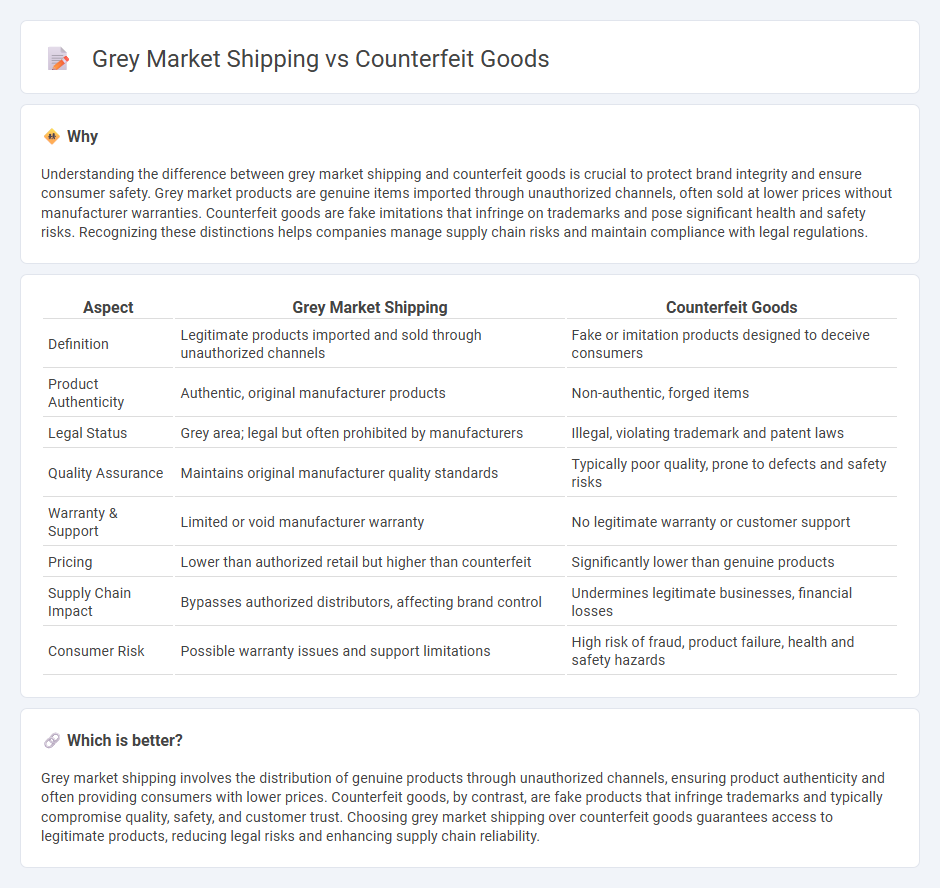
Grey market shipping involves the unauthorized import and sale of genuine products outside official distribution channels, often at lower prices but with legitimate brand authenticity. Counterfeit goods, in contrast, are fraudulent reproductions designed to mimic genuine products, posing significant risks due to inferior quality and potential safety hazards. Explore the critical differences between grey market shipping and counterfeit goods to protect your business and consumer trust.
Why it is important
Understanding the difference between grey market shipping and counterfeit goods is crucial to protect brand integrity and ensure consumer safety. Grey market products are genuine items imported through unauthorized channels, often sold at lower prices without manufacturer warranties. Counterfeit goods are fake imitations that infringe on trademarks and pose significant health and safety risks. Recognizing these distinctions helps companies manage supply chain risks and maintain compliance with legal regulations.
Comparison Table
| Aspect | Grey Market Shipping | Counterfeit Goods |
|---|---|---|
| Definition | Legitimate products imported and sold through unauthorized channels | Fake or imitation products designed to deceive consumers |
| Product Authenticity | Authentic, original manufacturer products | Non-authentic, forged items |
| Legal Status | Grey area; legal but often prohibited by manufacturers | Illegal, violating trademark and patent laws |
| Quality Assurance | Maintains original manufacturer quality standards | Typically poor quality, prone to defects and safety risks |
| Warranty & Support | Limited or void manufacturer warranty | No legitimate warranty or customer support |
| Pricing | Lower than authorized retail but higher than counterfeit | Significantly lower than genuine products |
| Supply Chain Impact | Bypasses authorized distributors, affecting brand control | Undermines legitimate businesses, financial losses |
| Consumer Risk | Possible warranty issues and support limitations | High risk of fraud, product failure, health and safety hazards |
Which is better?
Grey market shipping involves the distribution of genuine products through unauthorized channels, ensuring product authenticity and often providing consumers with lower prices. Counterfeit goods, by contrast, are fake products that infringe trademarks and typically compromise quality, safety, and customer trust. Choosing grey market shipping over counterfeit goods guarantees access to legitimate products, reducing legal risks and enhancing supply chain reliability.
Connection
Grey market shipping often involves the unauthorized distribution of genuine products through unofficial channels, bypassing standard logistics regulations and diluting brand integrity. This unregulated flow creates vulnerabilities that counterfeit goods exploit by infiltrating these same networks, making detection and quality control more challenging. Efficient supply chain monitoring and authentication technologies are crucial to distinguishing legitimate shipments from counterfeit items and mitigating risks in logistics operations.
Key Terms
Product Authentication
Counterfeit goods are unauthorized replicas that infringe on trademark rights and typically lack the quality and safety standards of genuine products, whereas grey market shipping involves the legal import and sale of authentic products through unofficial channels without the brand owner's consent. Product authentication remains critical in distinguishing genuine items from counterfeits, often utilizing technologies like holograms, QR codes, and blockchain tracking to verify legitimacy. Learn more about effective product authentication methods to safeguard against counterfeit risks and ensure brand integrity.
Parallel Importation
Parallel importation involves the legal import of genuine products through unauthorized channels, distinguishing it from counterfeit goods, which are fake and infringe on trademarks. Grey market shipping occurs when authentic items are sold outside the official distribution network, often leading to warranty and authenticity concerns but not intellectual property violations. Explore more to understand the complexities and legal nuances of parallel importation versus counterfeit product distribution.
Supply Chain Traceability
Counterfeit goods undermine supply chain traceability by introducing unauthenticated products that bypass official channels, resulting in compromised quality and safety standards. Grey market shipping involves legitimate products sold through unauthorized distributors, complicating inventory tracking and warranty validation without directly affecting product authenticity. Explore effective strategies to enhance supply chain traceability and mitigate risks associated with counterfeit and grey market goods.
Source and External Links
Counterfeit consumer good - Counterfeit goods are illegally made or sold products without brand owner authorization, often violating trademarks; usually lower quality and potentially risky, these goods represent about 2.5% of global trade and are found worldwide across many industries from luxury items to everyday products.
Counterfeit goods: a bargain or a costly mistake? - The trade in counterfeit goods is a massive, global criminal enterprise involving a wide range of products, from fashion to pharmaceuticals, posing serious health, safety, and economic risks, often linked to organized crime and poor-quality, dangerous items.
Counterfeiting (Intended for a non-legal audience) - Counterfeiting is illegal in most countries, involving fake products sold via markets, stores, and especially online platforms, with counterfeiters using deceptive tactics such as stolen brand images to trick consumers into buying fake goods that originate mainly from developing countries with low-cost manufacturing.
 dowidth.com
dowidth.com